Burdock root is a terrific garden vegetable full of vitamins and minerals amazing medicinal properties – it’s also delicious if you know how to cook it properly! It’s perfect when simply roasted in olive oil with salt and pepper – the flavor is nutty with a slight chew. Learn how to cook burdock root with a few extra additions to make your roasted burdock root extra special!
What is Burdock Root?
Burdock is a plant that is useful in so many ways, but we often don’t know what it is or what in the heck to do with it.
Burdock roots are usually long and fairly thin, with a brown skin. They are in the thistle family, same as the artichoke, of which they have a similar flavor.
It may not be the most common vegetable around, but if you see burdock root at your local market, you should buy some just to see what it’s all about.
Burdock is also easily foraged as the plant grows wild in most of the country.
Burdock is great for your garden in that the long roots break up the soil and the leaves can be used for mulch. It is in season during the fall and winter, as are many roots like dandelion root.
It is a powerful medicinal, good for many ailments. Burdock root was traditionally made into a dandelion and burdock soda or beer, which sounds like my cup of tea.
Burdock has prickly seed heads that stick to everything were also the inspiration behind Velcro.
Beyond all that, however, burdock root is an awesome food source, full of vitamins and minerals!
The first time I ever encountered a burdock root was in a winter CSA veggie box, and I had no idea what to do with it. But I discovered a simple way to make it delicious!
Here I will show you how to cook burdock root so that you’re not in the same position I was.
How to Cook Burdock Root
Burdock root, also known as gobo, is popular in Asian dishes. It works very well in stir fries, braises, and soups.
Burdock root can also be peeled, sliced and eaten raw out of hand or on a salad. It resembles a radish with a slight artichoke flavor when eaten this way.
It oxidizes very quickly when cut so it’s good to put the raw slices in a bowl of lemon water to prevent browning.
Roasted Burdock Root
Roasting it is my favorite way to cook burdock root.
I actually like the flavor of the skin, as I find it adds a certain nuttiness that is really amazing, so I don’t peel it. But it can be peeled if you prefer.
If you don’t peel it, make sure to wash the roots really well to get all the dirt and grit off, just like you would with a potato.
Then slice the root into rounds.
Work quickly to avoid the color changing oxidation, but know that it doesn’t really effect the nutrient qualities in any way. It’s just more pleasing to the eye.
Put your burdock root rounds into a bowl and toss with a little olive oil, salt and pepper.
Spread the prepared burdock roots onto a sheet pan.
Roast in a preheated 400°F oven for about 15 minutes, or until golden on one side, then flip. Return to the oven for another 10 minutes or so.
Burdock root simply roasted like this is amazing with a nutty flavor and a slight bit of chew to them. I really find them irresistible!
But, what makes them out of this world is a couple of splashes of soy sauce and a sprinkle of sesame seeds.
It’s not only healthy and delicious, but also super easy. Not to mention beautiful, if I don’t say so myself!
A quick and tasty side to any meal, we served it with a nice piece of salmon.
Burdock root can really be used like most other root vegetables, it just has a bit of a different texture and flavor than most are used to. In my opinion, that’s a good thing!
Sometimes when I feel burnt out on “regular” veggies I will buy the most uncommon or weird looking vegetable just to see what it’s all about.
I’ve never met a veggie I didn’t like, and burdock root is no exception!
I hope this post inspires you to go out and cook up some burdock root!
Learn How to Cook Other Vegetables
Here are a few other not-so-usual vegetables you may need a little help learning to prepare in a way that makes you fall in love with them at first bite!
- 8 Ways to Eat Radishes & Their Greens
- How to Cook Turnips & Their Greens
- Easy Ways To Cook Winter Squash
- How to Cook & Eat Artichokes
- How to Cook Jerusalem Artichokes
- What to Do with Cabbage
- How to Cook Beets & Their Greens
Roasted Burdock Root
Equipment
Ingredients
- 1 lb burdock root
- 2 Tbsp extra virgin olive oil
- pinch salt
- pinch pepper
- 1-2 tsp soy sauce or tamari optional for serving
- 1-2 tsp sesame seeds optional for serving
Instructions
- Preheat the oven to 400°F.
- Wash the burdock roots well to remove any dirt and grit, then slice into one inch rounds.
- Place the burdock rounds into a bowl and toss with olive oil, salt, and pepper.
- Spread the roots out onto a sheet pan, cut sides down. Roast for 15 minutes or until golden on one side, then flip. Return to the oven for another 10 minutes.
- Add a splash or two of soy sauce and a sprinkle of seasme seeds when serving, if desired.





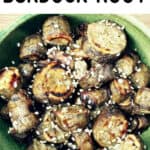
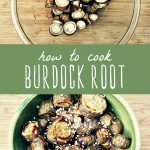
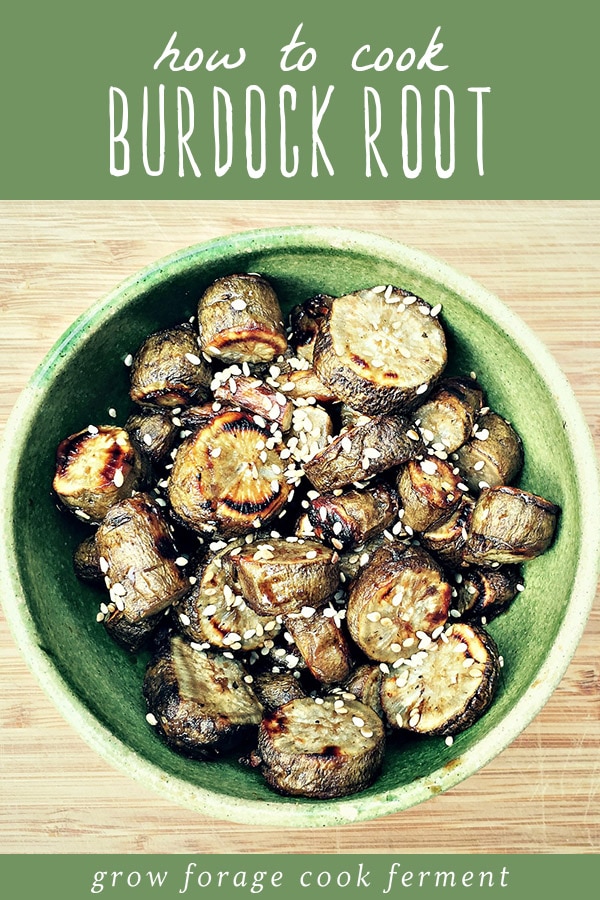

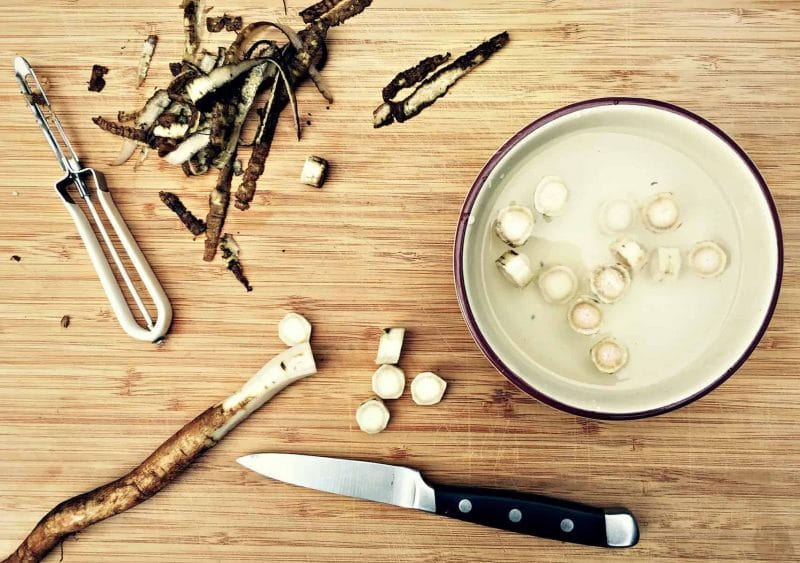
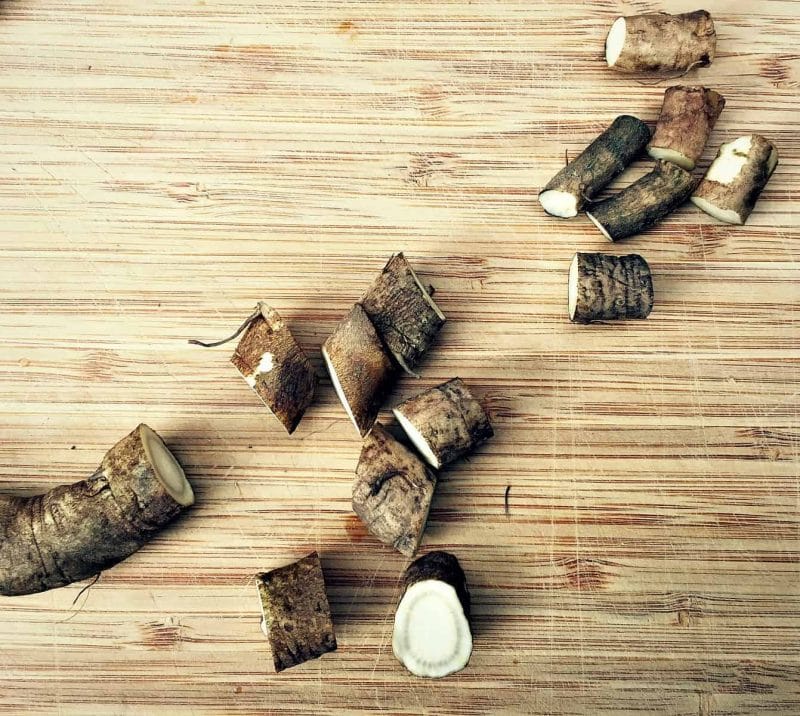
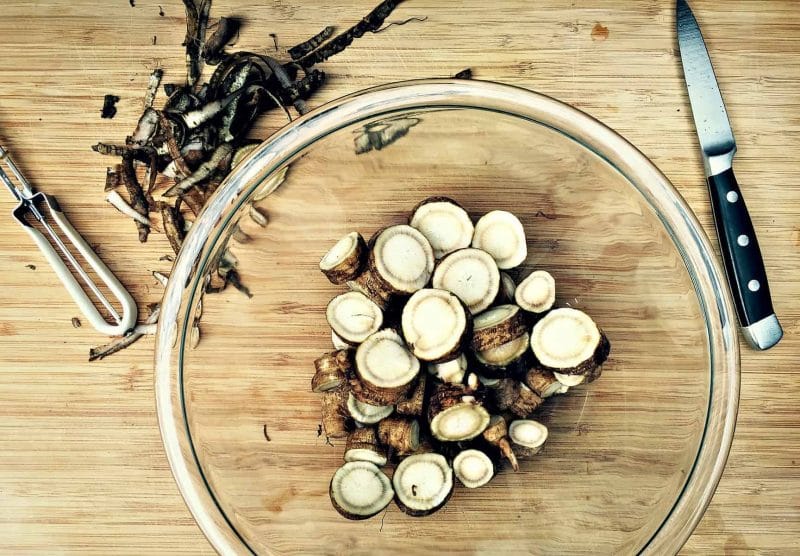
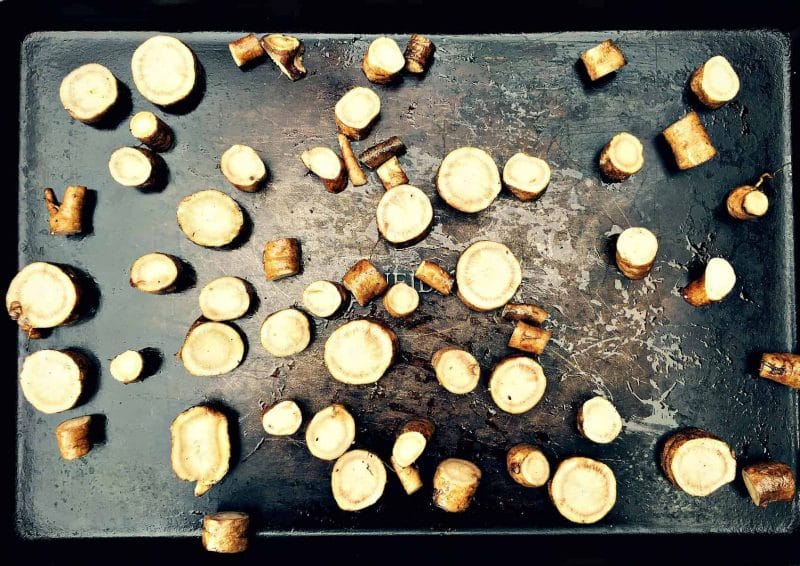
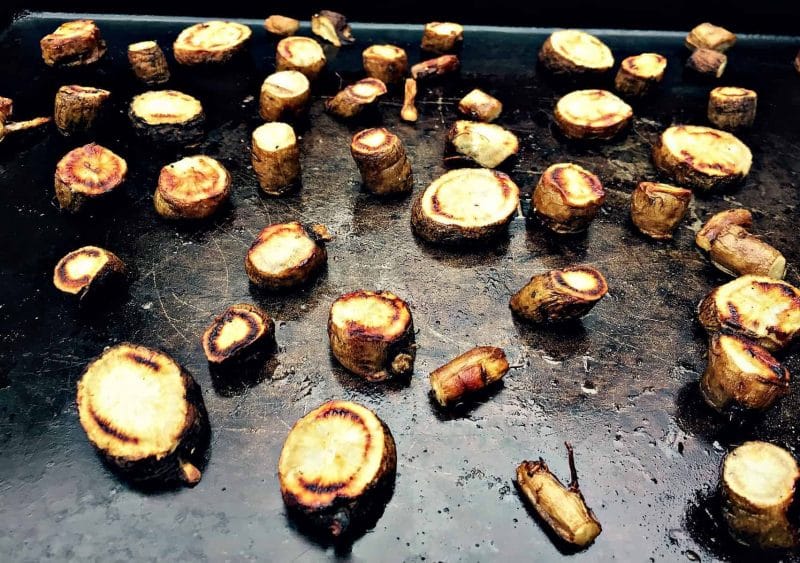
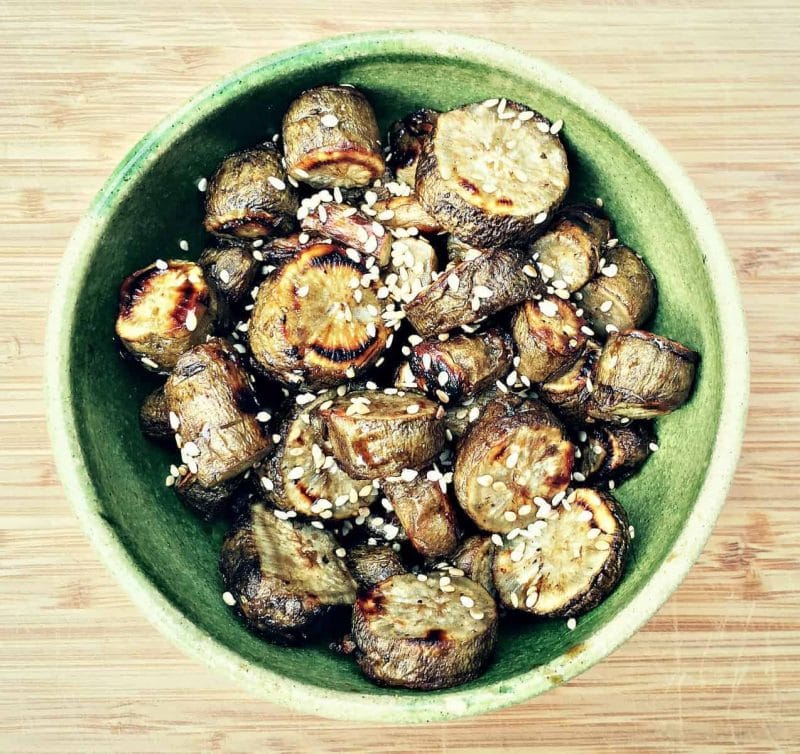
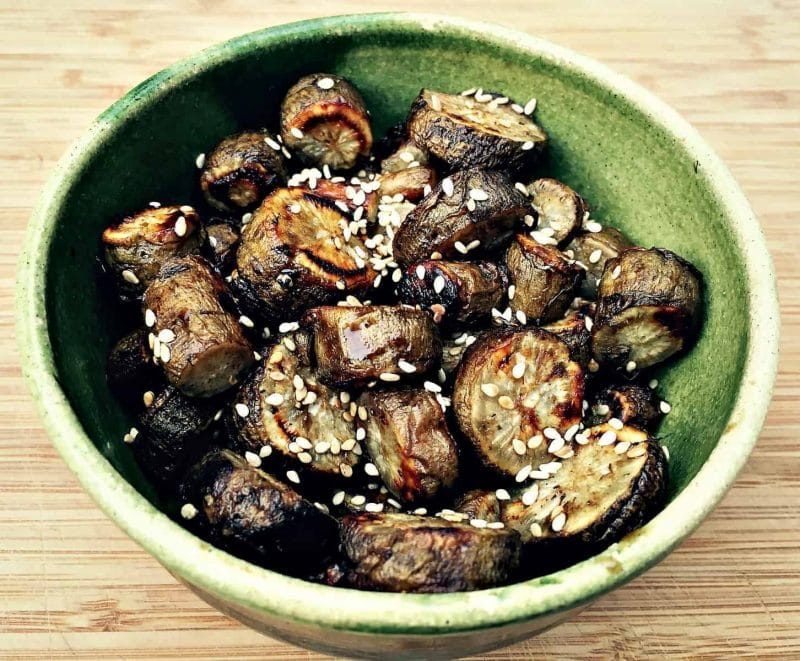


Enjoyed reading all the post referencing Burdock root, and looking forward to trying them out in recipes and planting.
Will search now how to identify them in the wild.
Thanks!
Margaret
Yum! Burdock! So delicious and nutritious. I usually just drink it as tea. Or add it to soups. So very good for you!
Burdock is a weedy bane to my gardening experience but I’m fortunate that I live in sandy soil so, while a pain in the neck, they’re not that hard to dig out (I have a shovel with a long, thin blade for just such a purpose). I’ve been looking for a way to use the many, many I have. Psyched to try this. Thanks.
Had GOBO many times in Japan, if you like fiber in your diet then this is the root veggie for you. Has a earthy/smoky flavor and I love it.
Gobo is well known in Japanese cuisine. An easy dish common in Japan is called “kimpira”. Wash the root well and peel, usually by scraping with the back of a knife. Cut into desirable length and julienne or match-stick. Do the same with carrots. Cook together in dashi with a little soy sauce, mirin, and crushed red pepper flakes for a little kick. Cook until crisp-tender.
I live in Southern Ontario and my farm is full of Burdock. The only way to keep them under control is to treat them like a dandelion and cut the stalk just below ground level. That will kill the plant and then it won’t flower and spread.But still new ones appear every year. I am so happy to have read this information. I will definitely let some new so I can enjoy the benefits of Burdock.
I got an old elixir bottle with burdock root liquid still inside. This is interesting. Thanks for the info.
I plant my burdock in the spring and then start harvesting it in midsummer, when it’s about the size of a pencil and tender and crisp like a carrot. (The tender skin doesn’t need to be peeled on such young roots.) Then I continue to harvest it as needed until it starts to sprout in the spring. The last roots can be dried and used for tea, so we can literally use it every month of the year.
you actually plant it? i cant seem to stop he spread of mine.
Do you use the roots or leaves to make tea? Instructions plz. Thanks! NT
Living in northern MN, with a long haired dog, Burdock may just be the most hated weed in the world, certainly never considered eating them, might have to try that way of killing them off! solarizing the soil, burning, ripping up roots and all wont get rid of them. Be wary if you plant these, and don’t let them go past flower. If anyone wants seeds, please don’t pay for them, Ill give them away, how many 5 gallon buckets of them would you like?
LoLLL, I hear you Re: your pet, Even your pants are in jepordy [r anything else that touches these weird ass plants….I don’t particularly like them but know After battling Cancer, Natural is Soooo Much Better…Do you possibly still have seeds??
I’ve beatin my Demon for now an these silly plants are anoucense buttt if I can eat the thing that’s what I’ll do….Life is Gift!
Therefore, if there are ANY seeds pls. Let me know….. hopefully I like them, LoLLLL
I would love to have some!
I’m glad, I just stumbled upon this post. A few days ago I spotted burdock nearby and thought by myself, that I’d have to wait till spring, before I could use parts of the plant. Didn’t think of the roots. Can they be un-earthed and eaten even after frost?
Many roots are even better after a frost, and I’m betting that burdock is one of them! It may even make them more digestible, like Jerusalem artichoke.
Thanks, Colleen! I’ll try…
Does any one know what is the best time to pull them… I have loads of burdock and work to get rid of it. If I could eat it, it would make me feel better to get rid of it.
I read in the Bountiful Gardens seed catalog to plant in Spring, and harvest in the late Fall or early the . following Spring Side note: They also offered this interesting suggestion that I will be trying: “try using burdock instead of black tea to make spiced chai tea” They offer two varieties of burdock, one with really long roots, and one with roots that grow to only about 6″ long.
I’m so happy to have found fresh burdock root in an Asian market today. I started using dried burdock seven months when I read About it’s healing qualities Now my iron levels are in the lower normal range for the first time since I was a child. I will continue it as it is reported to be a blood purifier.
Burdock also grows wild here in the UK, so it’s possible to forage for it – but you need the permission of the landowner to dig up roots, that’s the law. Thanks for sharing your cooking tips!
This is fascinating! I have never heard of burdock root, but if it tastes like an artichoke I will be on the look-out for it! Thanks, Colleen…
I wonder how they are harvested commercially? And how long does it take them to grow so many feet down? And how to identify them. And how a person foraging for them could actually harvest them. Is there a special tool? They sell them at the local Asian market–a big bunch of them pretty cheap. But I only ever see the roots–not the leaves.
If the roots are cultivated and soil is tilled like on a farm, it is looser and much easier to dig up the roots. Also we grew some at home (smaller amount for personal use) and used a barrel, and at harvest time, we took the sides off of the barrel to have easy access to the roots :)
This is cool. Been wondering how many of these “root plants” one could eat.
I enjoyed this post as we have lots of burdock growing in the wet areas of our canyons. However, I found they can’t just be pulled up out of the ground. As you stated they have a long tap root. Since they’re considered invasive, I’m sure no one would mind of I brought along a shovel and starting digging them up next fall. Have you tried the leaves? I did munch a young leaf raw once but didn’t find it that tasty.
Yes, I’ve heard the roots are hard to dig up… I’ve never foraged for them myself, but would love to! The leaves are supposedly edible, but I haven’t tried them.